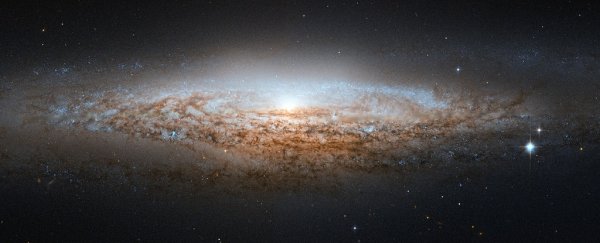We've been looking for decades for dark matter, yet the mysterious stuff remains undetectable to our instruments. Now, astrophysicists have explored an intriguing possibility: what if it's not dark matter that's affecting galactic rotation after all. What if it's the mass of light instead?
In a 1980 paper, the American astronomer Vera Rubin pretty conclusively proved something really weird about galaxies: their rims are rotating far faster than they should be.
As we move out from the galactic centre, the orbital motion of the stars and gas in the disc should theoretically slow down, with the decrease in velocity proportional to the distance from the centre.
This is called Keplerian decline, or decreasing rotation curve, and it can be observed quite neatly in planetary systems like our own Solar System. But most galaxies don't actually do this.
Instead, their rotation curves either remain flat, or actually increase. Those outer stars are orbiting much more quickly than they should be, based on the gravitational effect of the matter we can observe.
So astrophysicists hypothesised dark matter. We don't know what it is, and we can't detect it directly. But unless all our current understanding about the physical Universe (and all the data we've collected on the phenomenon is wrong), something out there is definitely making extra gravity.
But that something might not be dark matter, according to a team of researchers – specifically, plasma physicist Dmitri Ryutov, who recently retired from the Lawrence Livermore National Laboratory in California, and Dmitry Budker and Victor Flambaum of the Johannes Gutenberg University of Mainz in Germany.
In a new paper, they lay out an argument that light particles (photons) are at least partially the source of the phenomenon - causing an effect that isn't gravity, but behaves a heck of a lot like it.
"The hypothetical effect we are investigating is not the result of increased gravity," Budker said.
"By assuming a certain photon mass, much smaller than the current upper limit, we can show that this mass would be sufficient to generate additional forces in a galaxy and that these forces would be roughly large enough to explain the rotation curves. This conclusion is extremely exciting."
The effect they describe is a sort of "negative pressure" caused by electromagnetic stresses related to the photon mass.
When placed in the context of a mathematical system called Maxwell-Proca electrodynamics, these electromagnetic stresses can generate additional centripetal forces, acting predominantly on interstellar gas. The team calls this Proca stress, and it acts a lot like gravity.
So, yes, it's all purely hypothetical at this point. And it's not perfect.
On the one hand, short-lived stars that are born from gas (and rapidly return to gas before completing one orbit) would be strongly coupled with the gas; the Proca stresses acting on the gas would be indirectly also acting on these stars.
But longer-lived stars create a problem. The Sun, for example, is around 4.6 billion years old, and orbits the galactic centre once every 230 million years, so it's had a few turns on the roundabout. According to the team's calculations, it should have a highly elliptical orbit under Proca stresses.
And yet it does not. So the theory would need a bit of work to be compatible with our actual observations of the Universe. For now, dark matter is still king. But there's no harm, and potentially a lot of good, in looking for other explanations too.
"We don't currently consider photon mass to be the solution to the rotation-curve problem. But it could be part of the solution," Budker said.
"However, we need to keep an open mind as long as we do not actually know what dark matter is."
The research has been published in The Astrophysical Journal.
